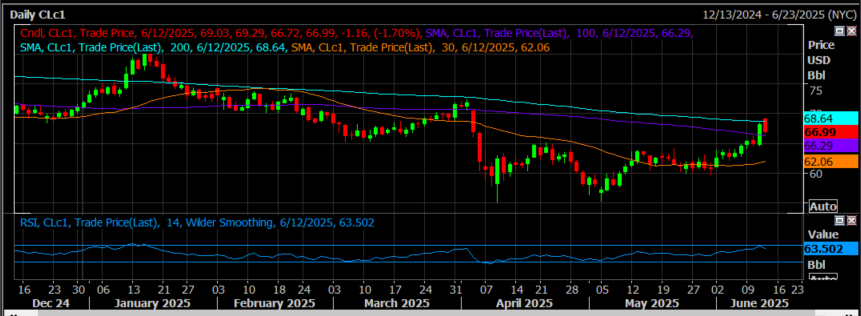Middle East Tension: Foreign energy companies are continuing normal operations in Iraq despite rising regional tensions, according to a senior Iraqi official. The Iraqi oil ministry has not received any notifications from companies about staff reductions in the country's southern oilfields. This follows U.S. President Trump's statement that U.S. personnel are being moved out of the Middle East because "It could be a dangerous place". Reports also indicate the U.S. is preparing to evacuate its embassy in Iraq amid growing security concerns.
OPEC Demand Outlook: OPEC Secretary General Haitham Al Ghais stated that global oil demand will remain strong through 2050, driven by population growth, with energy needs expected to rise 24% and oil demand surpassing 120 million barrels per day. He emphasized the importance of continued investment in oil and gas, warning that underinvestment could threaten energy security and increase market volatility, with OPEC estimating a need for $17.4 trillion in capital over 25 years. Al Ghais praised Canada’s oil industry for record production in 2024 and supported technological solutions like carbon capture to cut emissions without abandoning fossil fuels. Despite this outlook, oil prices face downward pressure due to rising OPEC+ output and economic concerns, with Brent crude projected to fall below $60 per barrel by year-end.
EIA Inventory Report: For the week ended Friday 6/6, EIA data showed gasoline inventories grew by 1.5 million bbl while distillate was up 1.2 million bbl. Crude oil stocks dropped 3.6 million bbl last week, while the weekly domestic oil production level remained well above 13 million b/d. Refiners appear to be hitting their summer stride as gross runs jumped to 17.364 million b/d, a utilization rate of 94.3%. EIA calculated gasoline demand at 9.17 million b/d, up 907,000 b/d from the week prior. ULSD demand was estimated 225,000 b/d higher at 3.376 million b/d.
Market Overview: Oil prices are moving lower Thursday morning, as traders responded to the U.S. decision to reposition personnel in the Middle East ahead of critical nuclear talks with Iran. WTI crude retreated about 1% after surging more than 4% the previous day due to escalating regional tensions. Concerns grew over potential disruptions to oil supply, particularly if Iran were to block the Strait of Hormuz, which handles about 20% of global oil flows. The market is also watching Sunday's U.S.-Iran talks closely, with hopes for de-escalation, although both sides have issued threats if negotiations fail.

WTI Crude has been gaining momentum over the past couple weeks as the contract has approached $67.00 a barrel. The big number that most analysts are keying in on is $70 a barrel, can WTI crude get back above $70 and stay above that mark. Currently WTI has passed its 30 day moving average (orange) of $62.06, it has passed its 100 day moving average (purple) if $66.29, while its 200 day moving average (teal) of $68.64 is another line of resistance in between that $70 mark. Look for the 100 day moving average to act as a support line today and look to see if it can close below that mark to indicate any more weakness in the contract.

Oil prices dipped slightly on Thursday as traders weighed whether recent gains had already accounted for supply risks stemming from heightened Middle East tensions. Prices had surged over 4% on Wednesday following the U.S. decision to withdraw personnel from the region, pushing markets into overbought territory. Rising geopolitical tensions, including Iran's refusal to halt uranium enrichment and threats of retaliation against U.S. forces, have sparked fears of potential oil supply disruptions. Analysts warn that a closure of the Strait of Hormuz, a key oil transit chokepoint, could drive prices to $120–$130 per barrel, although such a scenario is seen as unlikely. Despite the current caution among traders, uncertainty remains high as diplomatic efforts continue and the U.N. escalates pressure on Iran over nuclear compliance.

